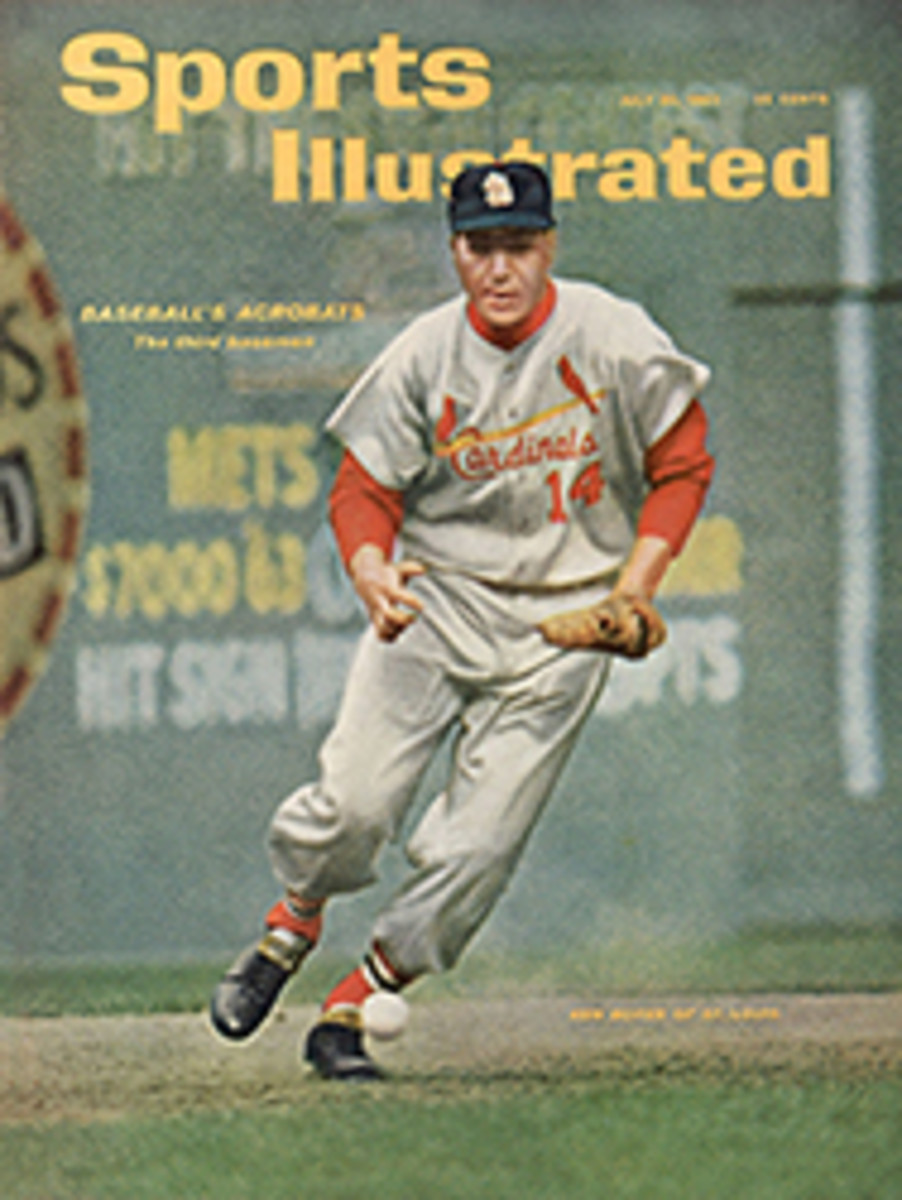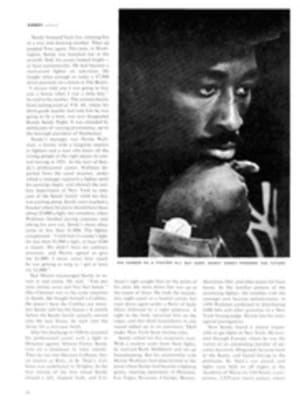
TIME OF TRIAL FOR FOUR TALL SLOOPS
For two weeksthis July, at about 10 o'clock each morning, a vessel flying the oversizedflags of the New York Yacht Club and its race committee dropped her mooring offNewport and headed to sea, past the clipped green lawns, past Castle Hill, pastthe striper fishermen on the rocks, to a rendezvous at Brenton Reef lightship.Each day in her wake trailed a handsome fleet, yachts large and small, powerand sail, to await the hoisting of signals that would set the course for theday's racing.
The seagoingparaders were there to watch four tall, 12-meter yachts—Columbia, Weatherly,Easterner and Nefertiti—compete for the honor of being named the 18th defenderof America's Cup. In pairs they raced while the floating grandstand followed,and each night Newport's pubs and clubs filled with discussions by intense andknowing fans, using terms like spinnaker jibe and inside berth at the mark.
Yet theirknowledge and their interest were mild compared to that of a number ofblue-jacketed gentlemen on the decks of two inconspicuous vessels. They wereconstantly peering through binoculars, glancing at stopwatches, conferring,jotting notes. There was no slow tack, no buoy overstood, no helmsman's errorthat was not duly observed and recorded against the day of judgment when thedefender will be chosen. For the point of the whole show was to permitobservation by these gentlemen, the selection committee, whose duty it is tomake certain that the American yacht with the best chance of defeating theAustralian challenger Gretel is the one that comes to the starting lineSeptember 15.
In its duties,members of the nine-man committee are only slightly less solemn about thedefense of the cup than those leaders concerned with the defense of ourcountry, and they are considerably less talkative. Nobody really knows whatgoes on in midships huddles during the races, or what is discussed in formalsessions afterwards. Yet it is no secret that far more is considered than themathematical percentage of wins versus losses, as disclosed by a frequentquestion among the more knowledgeable of the fleet spectators: "How do youthink so and so looked to the committee?"
Overall, thecommittee got an uncommonly clear look for such an early stage in the trials.During the 13-day period, in which 22 races were held, the weather pattern wasgood. There were no drifting matches when time limits expired, and only oneevent was postponed by fog. Twice the wind piped to a sustained velocity ofsome 18 knots, and one day was a real snorter, exceeding anything encounteredduring the entire '58 season.
Before the trialsstarted the greatest question was Nefertiti (SI, June 11). There were those whohad viewed Sailmaker Ted Hood's first attempt at meter-boat design withmisgivings, speaking learnedly about frontal resistance and wetted surface; butthe most succinct doubt was reportedly expressed by a respected naval architectwhen he viewed Nefertiti hauled out on the eve of festivities. He laughed.
But nobody evensnickered after the portly maiden celebrated her debut July 2 by defeatingColumbia, the 1958 cup champion, and went on next day to beat Easterner. Bythese victories she established herself as fast in light to moderate air, whenmany had believed she would be at her worst. She was less efficient to windwardthan anticipated, definitely logy before the wind, but a demon reaching.
Meanwhile, on thesame two days, Henry Mercer's Weatherly was matched against the same twoadversaries in reverse order, and defeated them both. It was clear that changesin the light blue sloop had been for the better. How much was due to a heavierkeel and how much to Bus Mosbacher at the helm would be impossible to say, butWeatherly quickly demonstrated that this year she is able to go upwind as wellas down.
The twoundefeated boats met for the first time July 4. Before her mooring was droppeda Weatherly crew member muttered, "Today, it's man against thebeast"—Bus Mosbacher against the powerful hull and monster headsails ofNefertiti. Mosbacher went ahead at the starting cannon and quickly tamed thebeast. Under his hand Weatherly simply sailed faster, her superiority greateston the second windward leg, when Nefertiti surprised and disappointed hersupporters by seeming to lay over and get nowhere, ending up five minutes 43seconds astern. Still the Anderson group was not in the least dismayed."Wrong jib," said Don McNamara, Ted Hood's co-helmsman. "We'relearning. It'll be different next time."
Weatherly went onto another victory the following day in her second match against Easterner,making her score four straight. But then in the next three she came apart:brand-new gear gave out, winches identical to those on the other boats failed,and the crew fumbled at crucial moments.
Monday broughtrain and 30-knot squalls, which lashed the gray water into savage seas.Easterner, sailed for the first time throughout a race by designer Ray Hunt,defeated Weatherly. She relished the wet windward work, showing power notmatched by any rival. For Columbia, the heavy-weather slugger of '58, the daybrought disaster. Leading Nefertiti shortly after the start, her mast snappedat a weld, leaving her helpless. Two crewmen went overboard, one beingretrieved by the team of Australian observers following close astern; and onlythe fact that he had just moved to the edge of the cockpit to take a bearingkept Navigator Olin Stephens from being under the guillotine of the boom.
Columbia was backin action Thursday. But the week really was distinguished by Nefertiti andWeatherly continuing to pile up victories. When they finally met again onSaturday, a win by Weatherly would mean a 3-1 edge over her strongest rival.Conversely, a victory by the Hood boat would give Nefertiti the most impressiverecord since the j-class defender, Ranger.
Mosbacher got thebest of the start in a breeze of some 12 knots, but both came to the windwardmark together, Nefertiti inside on the turn. Downwind, the two ran for a longtime as though pulled by the same string, until finally Weatherly opened out afew lengths. Helmsman Hood bided his time. About a mile from the leeward markcame Nefertiti's move, sharpening up to blanket Weatherly. There was a seriesof maneuvers, marred somewhat by faulty sail handling aboard both boats,culminating in two rips in Weatherly's spinnakers, but she managed to lead atthe mark.
The wind had nowfreshened to 18 knots. Earlier Nefertiti had failed to show power in suchconditions. Not this time. Hood tacked at the buoy to clear his wind, but whenWeatherly covered he merely drove off, then proceeded to work out to windward.About halfway through the leg Mosbacher in desperation instituted one of hisfamous tacking duels, but it failed to gain. Later, nearer the Narragansettshore in smooth water, he tried again, and this time narrowed the gap until theport coffee grinder winch failed. From then on, tactically unhampered,Nefertiti sailed away to cross the finish line nearly a minute ahead, adeserved and impressive victory. Her final won-lost total for the trials was10-2, while Weatherly finished the series 7-4. Columbia was 4-5, and Easternerhad only a single triumph in 11 starts.
On any basis,Nefertiti's overall performance was impressive. A brand-new boat, with anuntried crew and—oddly enough—a skimpy sail inventory, she still managed towin. True, on at least three occasions she was presented with victories byrival helmsmen, who had allowed her to sail divergent courses, and she wonanother race through Columbia's breakdown. But there is no gainsaying that as anew boat she has the greatest potential for improvement, and is already mightyhard to stay ahead of around a course. Perhaps more of this may be attributedto Hood's and McNamara's smart cockpit work than is generally realized, whilethe muscle trust amidships and forward has contributed by handling the giantgenoas and spinnakers with only a few lapses, one of which is shown on page22.
Weatherlyperformed like a new boat. She was plagued by mishaps, most of which should nothave happened to a vessel so meticulously maintained, yet her crew wasimpressive in recovering from chance disasters—as when a jib halyard failed—andshe still won. Bus Mosbacher remains the master tactician and helmsman of the12s, with an uncanny knack of working to windward. In average conditions—windsof 15 knots or less—no other boat seemed quite as fast on all points ofsailing. Before Saturday, she had even seemed stiff to windward in heavier air.Perhaps getting caught with a light mainsail that went out of shape was thereason for her apparent lack of power, an impression she will have anopportunity to rectify in later trials.
It is the formerchampion, Columbia, that is hardest to evaluate. She may have had the best crewwork of the quartet, yet she lost races seemingly won. Nobody feels themodification of her keel hurt her speed, and her sails are as beautiful asever. The difference must lie in improvement by her competitors, or lessefficient helmsmanship, and is probably some of both. Young Glit Shields isunder tremendous pressures, and as the youngest skipper perhaps needs time toadjust to big-boat competition. By the August trials he may have found histouch, returning Columbia to her old status as the boat to beat.
Easterner remainsthe enigma she has always been, showing flashes of speed, but never becoming awinner. Steadily, toward the end of the series, she was reducing the margin bywhich she was defeated; she lost a couple of heartbreakers that might well havebeen victories. With new sails now on order and all hands more familiar withthe boat, she could show a great improvement in moderate conditions, and isalready acknowledged the best in heavy going.
The four boatswill meet again for the final trials beginning August 15. While the boats tackand countertack, the cup committee will be watching, binoculars poised andstopwatches clicking. And behind the solemn committeemen will be a wall ofspectator craft whose passengers are crowding into Newport this summer not onlyfor the races but, as reported on page 38, for pub crawling, celebrity huntingand the general pleasure of being around this dowager queen of U.S. resorttowns in her busiest season.
PHOTO
RICHARD MEEK
IN DUEL WITH 'COLUMBIA,' CREW OF 'NEFERTITI' (LEFT) GOT SPINNAKER INTO HEROIC TANGLE, THEN LET SAIL SLIDE OVERBOARD
PHOTO
SCRAMBLING UP WINDWARD SHROUDS, MEMBER OF 'WEATHERLY'S' FOREDECK GANG CLEARS LINE DURING A SAIL CHANGE
PHOTO
DARING CREWMAN STRUGGLES WITH POLE AS 'EASTERNER' TRAILS 'NEFERTITI'

